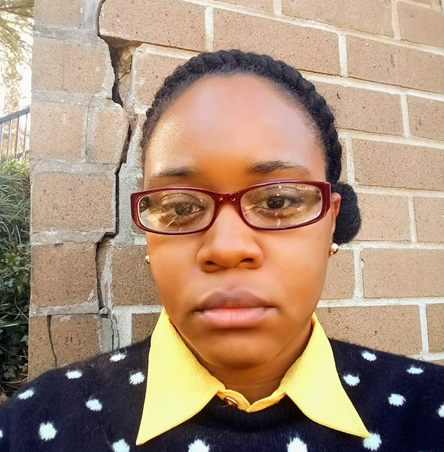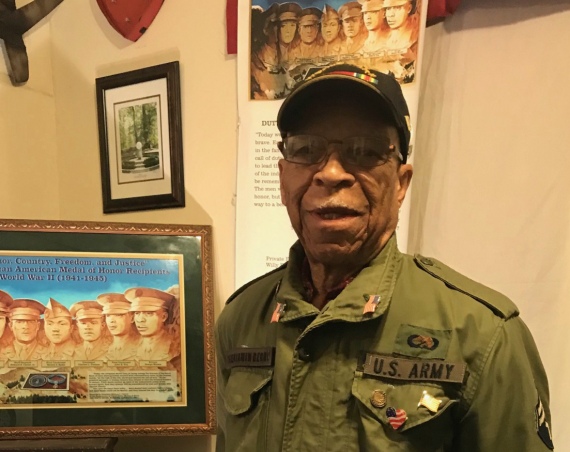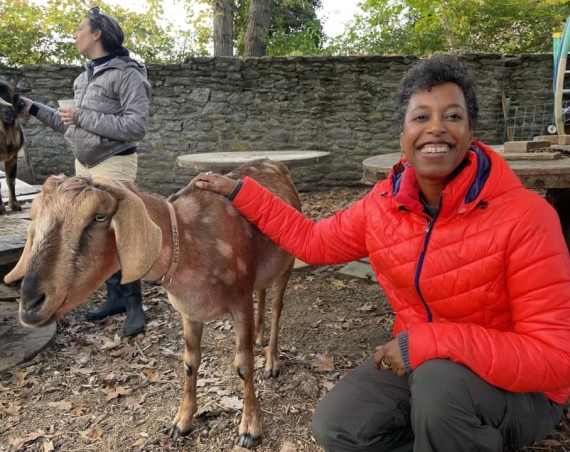
According to their website, Beyond The Bell Tours is committed to “putting the people back in people’s history,” as they offer a range of tours highlighting the often hidden histories of marginalized communities in Philadelphia. BTB offers walking tours throughout the year that usually highlight “Badass women ” of Philadelphia and Philly’s Gayborhood. Still, this year for Pride month, they sought to give the city a more comprehensive LGBTQ+ history by introducing the City of Pride Trolley Tour. This tour explores the historical significance and contributions of the LGBTQ+ community not only in the Gayborhood but across Philadelphia.
I took the fun-filled and colorful 2-hour tour, which traveled through parts of Center City and West Philadelphia, only to find out afterward that my loud and proud tour guide, Rebecca Fisher, resides in Germantown with her partner. The final tour was set for June 26th, but before it ended, Rebecca was gracious enough to have a conversation with me and talk a bit more about her involvement and work on the City of Pride tour and a little bit more.
–
Tell me a little about yourself.
I grew up in Jenkintown. And my grandparents were in Cheltenham, so I’m kind of like that part of the city. But they’ve all had previously been in Mount Airy. And I stayed in Philadelphia for college, and I went to Haverford. And yeah, I’ve stayed in the area my whole life and really love Philly, and now I live in Germantown with my partner and big dog. And I love Germantown. I spent a lot of time in Germantown growing up and have always wanted to live here. I used to go to the Nile Cafe a lot in high school. Now, I live like two blocks from there.
How did you get into doing the tours with Beyond The Bell?
I mean, honestly, it was my weekend job. While I was in school, I would come to the city and I thought it was gonna be a way for me to practice my languages. It’s not. There’s like all domestic tourism in Philly.
But you don’t have to spend a lot of time getting tourists to be like, “Okay, there’s no women, there was no queer people, there’s no people of color.” And I kind of felt like so many people come to Philly to learn about American history and to really like talk about America, that it was kind of like a powerful place to have the conversations that people might not be willing to have in other environments. And I was like, okay, I’m giving this tour, but could I be giving a better version of a tour? And that was kind of how some of these tours emerged.
And why was that important for you?
I mean, it’s important to me, because I think if you come to Philly, and you only talk about Benjamin Franklin and William Penn and George Washington and people are only hearing those narratives in place of American narratives, I think the consequences of that are pretty severe.
How have you enjoyed the tours, and what’s your favorite thing about the tour?
I mean, I love it. I really do. I love giving tours. I love talking with people, I love sharing the stories that I think are so defining to the city. And there’s so much work to be done. And I just feel like this is my corner of the world where I can contribute. And it’s going well, the pandemic was horrible. Like, I mean, we can all spend hours and hours talking about how horrible the pandemic was. But, I think that, because we’ve built such a strong local following, we’ve done better than some other companies because we’ve always tried to cater to what people wanted to hear in the city for themselves, as well. Not just for, you know, like international tourists people coming to Philly the first time, like, it’s always been supposed to be locally grown as well.
My favorite thing about doing the tours is when someone on a tour really connects to a story. They ask more questions and they want to know more information. Maybe it’s like, a young woman connecting to one of the stories of women or like, etc., etc., etc., right? Like the queer people who come on the tour, who hear a tour only talk about queer people, which is maybe not an experience that they’ve had when talking about history. And that can be very, like, inspirational, especially for young people.
Has there ever been a time when someone’s question has led you to do your investigating and research?
Yeah, absolutely. People ask me questions all the time that I don’t know the answers to. And any tour guide that pretends like that’s not true, they’re just being arrogant. I’m trying to think of something recently that’s come up. What did someone share? I mean, a lot of times, like queer elders come on the tour and they share information with me that is very personal. So, a woman came on the tour. She is like, alive and well and she came on the tour to talk about Club 13 in the Gayborhood. And like, how it was like really where the strip was. When she came on the tour and she like really made me laugh. She’s like, “I made a lot of money on these streets.” *Laughs*And I was like, I love it. And she sent me a picture and everything. But that inspired me to like, do some more research about that and made me think a lot about how much has happened in terms of like underground back alleyway, which we talked about on the tour also. But how much criminal activity has been associated with the Gayborhood. And then like, as queer peoples are marginalized, they have to participate in things that get criminalized, and it’s like the cycle. And that these things take on a facade of like, respectable queer spaces.
There’s a lot of history uncovered on the tour. And while you do a great job of trying to highlight things not specifically mentioned in the tour route, there is a priority to talk about the sites and facts included. How do you prioritize that?
So, I went to the LGBTQ archives in the William Way Center, which is like an amazing place for people to go because it’s super wacky. And honestly, I talked to a lot of queer people over 50. *Laughs* And, obviously, like, when you talk to a lot, and not everyone over 50 is an elder, but you know, like queer elders, they’re all going to be like, well, the bar I went to is what you have to talk about. So you can’t like get caught up in their personal narratives. But, we had a form on our website for a little to submit people. But honestly, I tried out a lot of stuff. I went to see how people reacted, and people made suggestions as well. And I walk around the neighborhood a lot. We researched a lot of the art in the gayborhood to kind of think about what made sense. We ask ourselves, like, every time is the person that we’re including pushing the narrative that we’re trying to say? Or is there something else that we like about that person? Right?
So, like, continuing to kind of be critical all the way through and be honest about your own bias sometimes of like, am I gonna am I more likely to choose five lesbians, right? Sure. Yeah. So like, let’s be honest about that. And then we can like, move forward.
What have attendees said about the tour?
Um, honestly, people have been really thankful that there was a place for them to do pride. Besides just partying, right, which is fine, like queer joy is important and whatever people want to do is fine. I’m not critiquing that. But, I really did feel like this was a year to really process some information together and I wanted to kind of put forth some hopeful narratives and some resilient narratives, as we’re kind of entering into this like really challenging place. And also thinking about how all of the people that I talked about contributed in really different ways. And I mean, a lot of people really liked it. I think we tried to embody the queer joy with the music and kind of having like a fun atmosphere while also keeping true to the mission so that was kind of the goal of the tour.
What are your top three landmarks and things to talk about during the tour?
So I love where we did the cruising — the merry-go-round. Where that “no cruising” sign is there. So that was like a big inspiration of the trolley, because we don’t walk there during the walking tours too far. But like to be able to do that in a trolley as like a group of queer people I think is so powerful to be like, we’re going to defy this street sign. And then the street sign is so stupid. And it shows like how much power that block had to say that they didn’t want queer people there that they literally had a sign put up. And the city entertained that I think it shows so much about power dynamics. And I think it’s really like powerful to go around there. And the story is just fun, too.
Another thing we talk about, but of course is missing, is the Gloria Cesarez mural. I feel like the missing is like, that’s really important to look at as well. But I show imagery of her mural. And I love talking about her story. And I just think that she’s really someone who makes queer activity like this one possible in the gayborhood through like the work that she’s done. And through her activism, so I love to talk about her and the mural. And I think that there’s like a lot of momentum around trying to memorialize her in queer spaces. I’m thinking about how that is limiting. Like if we are always responsible for monumentalizing our own history, there’s a way in which like, that’s always at risk, if we’re talking about a marginalized community. So that’s what I think about with her mural, which was also very beautiful, and I like to show it as well.
And then my third story is I love the SEPTA is a Drag story with Charlene [Arcila]. I just think Charlene had like such a funny sense of humor. And I liked that she was this like, extremely incredible activist, but was never afraid to like make a joke, right? And so she was part of a group called RAGE — Runners Against Gender Exclusion. And then she goes on to create that protest called “SEPTA is a Drag.” And I love that about her.



